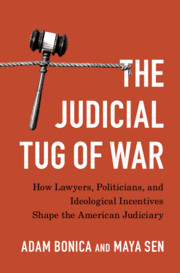 The Judicial Tug of War
The Judicial Tug of War from I - The Legal Profession and the “Captured Judiciary”
Published online by Cambridge University Press: 09 December 2020
How has a profession that has made itself so essential to the workings of every aspect of the political process – including the regulatory process – remained unburdened by government oversight and accountable only to itself? This is the question we address in Chapter 3. As we document in this chapter, the power of the bar led to an uneasy alliance between political actors; the bar sought more and more autonomy and, in line with a long-standing and natural connection with the judiciary, began to professionally “capture” the judiciary. It did so not only by monopolizing the candidate pool of potential judges but also by instituting rules about how lawyers (i.e., future judges) should be educated, implementing codes of judicial conduct, and, ultimately, making binding recommendations on how judges should be selected. In turn, the government has entrusted the “captured judiciary” with regulatory power over the legal profession. As we show through both qualitative and quantitative evidence, this symbiotic arrangement furthered the bar’s political and economic power.
To save this book to your Kindle, first ensure [email protected] is added to your Approved Personal Document E-mail List under your Personal Document Settings on the Manage Your Content and Devices page of your Amazon account. Then enter the ‘name’ part of your Kindle email address below. Find out more about saving to your Kindle.
Note you can select to save to either the @free.kindle.com or @kindle.com variations. ‘@free.kindle.com’ emails are free but can only be saved to your device when it is connected to wi-fi. ‘@kindle.com’ emails can be delivered even when you are not connected to wi-fi, but note that service fees apply.
Find out more about the Kindle Personal Document Service.
To save content items to your account, please confirm that you agree to abide by our usage policies. If this is the first time you use this feature, you will be asked to authorise Cambridge Core to connect with your account. Find out more about saving content to Dropbox.
To save content items to your account, please confirm that you agree to abide by our usage policies. If this is the first time you use this feature, you will be asked to authorise Cambridge Core to connect with your account. Find out more about saving content to Google Drive.